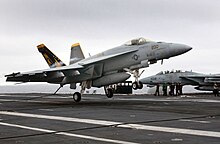Carrier-based aircraft
Carrier-supported aircraft are naval aviators that are specially set up for the use of aircraft carriers , the exact requirements depending on the particular carrier concept used. The additional equipment mainly includes a catch hook at the stern in order to bring the aircraft to a standstill quickly after landing with the help of the safety ropes on the deck of an aircraft carrier, as well as a reinforced landing gear to withstand the greater mechanical loads during the hard deck landings. In these cases one speaks of a CATOBAR or STOBAR principle. To operate on a CATOBAR carrier, an aircraft also needs a catapult take-off device . Carriers that are operated according to the STOVL principle usually use vertical take-offs as aircraft, which usually take off with or without a ski jump and land vertically. Foldable wings are helpful for more compact storage. Carrier-based aircraft can easily be deployed from land, but land-based aircraft cannot readily be deployed on board aircraft carriers. Many land-based military aircraft also have catch hooks, but they are only used in an emergency and then only on a runway.
Modern carrier-based aircraft in active service
On active duty
- Boeing EA-18G Growler
- Boeing F / A-18E / F Super Hornet
- Bell Boeing V-22 Osprey
- British Aerospace Sea Harrier
- Dassault Super Étendard
- Dassault Rafale M
- Grumman C-2 Greyhound
- Grumman E-2 Hawkeye
- Grumman KC-2 Turbo Trader
- Hawker Siddeley AV-8S Harrier
- McDonnell Douglas A-4KU Skyhawk (AF-1)
- McDonnell Douglas AV-8 B Harrier II
- McDonnell Douglas F / A-18 Hornet and Super Hornet
- Mc Donnell Douglas T-45 Goshawk
- MiG-29K
- Sukhoi Su-25UTG / UBP
- Sukhoi Su-33
- Shenyang J-15
